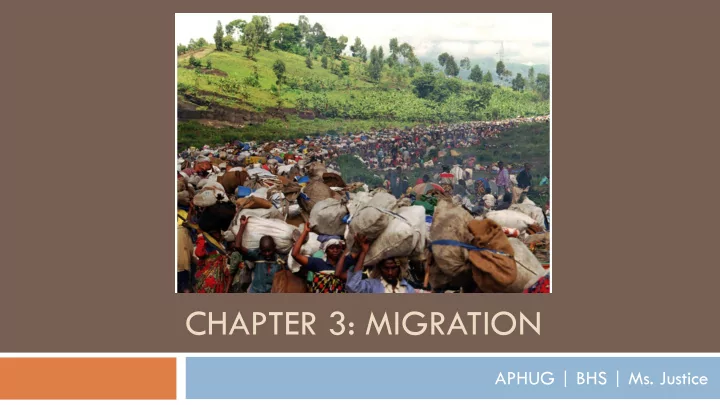

CHAPTER 3: MIGRATION APHUG | BHS | Ms. Justice
Key Question 3.3 Where do people migrate?
Where Do People Migrate? Global Migration Flows Global-scale migration – across international boundaries and between world regions Explorers – played a major role in mapping the world Colonization – colonizers take over another place, put their own government in charge, and move its own people into the place European colonization generated unprecedented migration
4 Level Analysis Complete a 4 Level Analysis of the following map (Fig. 3.11, p 94-95)
Where Do People Migrate? Regional Migration Flows • Economic opportunities • Islands of development • Role of globalization and colonialism
Where Do People Migrate? 2:34
Where Do People Migrate? Reconnection of cultural groups Conflict and war
60 Second Reflection In your notes, write a response to the following: Explain how the formation of Israel in the mid- 20 th century is an example of reconnection of cultural groups and conflict impacting migration.
Field Note “Just a few miles into the West Bank, not far from Jerusalem, the expanding Israeli presence could not be missed. New settlements dot the landscape, often occupying strategic sites that are also easily defensible. These ‘facts on the ground’ will certainly complicate the effort to carve out a stable territorial order in this much-contested region. That, of course, is the goal of the settlers and their supporters, but it is salt on the wound for those who contest the Israeli right to be there in the first place.”
Where Do People Migrate? National Migration Flows Historically, two of the major migration flows before 1950 occurred internally in the United States and in Russia. Russification sought to assimilate all the people in the Soviet territory into the Russian culture, during the communist period, by encouraging people to move out of Moscow and St. Petersburg and fill in the country.
Where Do People Migrate? Guest Workers Millions of guest workers live outside of their home country and send remittances from their jobs home. Their home states are fully aware that their citizens have visas and are working abroad. Despite the legal status of guest workers, many employers abuse them because guest workers are often unaware of their rights. Guest workers are legal, documented migrants who have work visas, usually short term.
Where Do People Migrate? Refugees The United Nations High Commissioner on Refugees (UNHCR) estimates that 83% of refugees flee to a country in the same region as their home country. The 1951 Refugee Convention defines a refugee as “a person who has a wellfounded fear of being persecuted for reasons of race, religion, nationality, membership of a particular social group, or political opinion.”
Where Do People Migrate? Refugees Internally displaced persons are people who have been displaced within their own countries, but they do not cross international borders as they flee. Hurricane Katrina victims Asylum : the right to protection in the first country in which the refugee arrives. Palestinian refugees in Jordan Repatriation : a process by which the UNHCR helps return refugees to their homelands once violence and persecution subside.
Figure 3.17 Zaire-Rwanda border region . Hundreds of thousands of mainly Hutu refugees stream out of a refugee camp in eastern Zaire (Congo), heading home to Rwanda in November 1996.
Where Do People Migrate? Regions of Dislocation North Africa and Southwest Asia: This geographic region, extending from Morocco in the west to Afghanistan in the east, contains some of the world’s longest -lasting and most deeply entrenched conflicts that generate refugees. More than half the refugees worldwide Africa: 2 million refugees are accounted for by international relief agencies, but also millions more are internally displaced persons. About 20% of the world’s refugees
Where Do People Migrate? Regions of Dislocation South Asia : The third-ranking geographic realm, mainly because of Pakistan’s role in accommodating Afghanistan’s refugees; also, Sri Lanka Southeast Asia : A reminder that refugee problems can change quickly Indochina’s refugee crisis
4 Level Analysis Complete a 4 Level Analysis of the following map (Fig. 3.18, p 104-5)
IMPACTS OF REFUGEES ENVIRONMENTAL SOCIAL Deforestation Disease Land degredation Crime/social strife Water pollution Famine
Recommend
More recommend